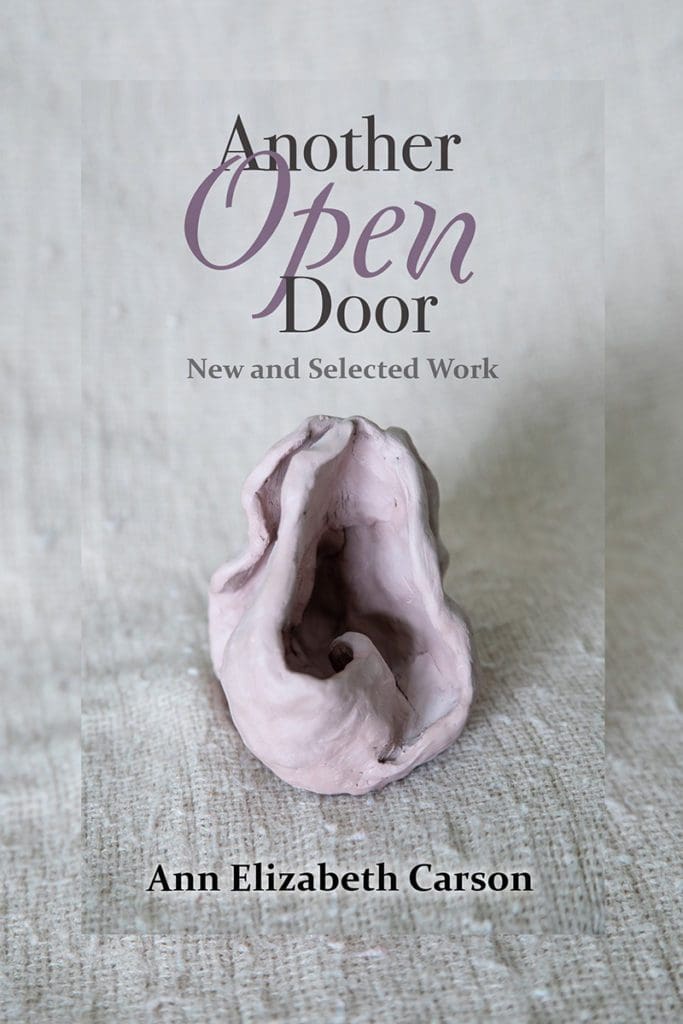Review: Another Open Door by Ann Elizabeth Carson
Reviewed by Donna Langevin
Another Open Door
Aeolus House, 2023
64 pages, $20.00
ISBN: 978-1-987872-56-9

Another Open Door is an inspiring melange of poetry, prose, music and artwork. As if to say, “Please enter without knocking,” the cover photo features Ann’s clay sculpture that suggests a listening ear or a shell’s portal. In each of the book’s three sections the clay takes on a new shape: In “Archival River,” it appears to contain a riverbed. “In Lifelines” two abstract figures embrace each other with what looks like a stone between them. “For the Time Being”showcases two figures moving apart, then on the last page they come together to dance. Complementing our multimedia experience, some texts contain links and QR codes to videos and music composed by Jana Skarecky.
Opening the door to the first section, “Archival River,” we are introduced to the author’s “Then and Now”timeless friendship with her “Artemis sister,” whom she deeply misses.In“Eating Memories” we savour Ann’s childhood as she takes out her Swiss Army knife to cut off a remnant sliver of an ice block carved from Monhegan Island Pond. A passionate environmentalist, she vents her rage in this section, as she wonders “how my species of animal/so wildly, unpredictably and continuously creative/is still destroying the world/creature by creature.” In “Bitter Sweet,” her poignant gratitude for her blessings includes the view of the trees outside her window, “their branches like a forest of paintbrushes tracing possibilities.”
Section 2 of this rich hybrid book welcomes the reader through the portal of the poet’s “awakening.” Her prose essay “Because of a Question” describes how she became a feminist. Born in 1929, “the year women officially became persons in Canada,” she guides us through the decades when “normal” women were expected to give up their careers upon marriage to become housewives, mothers, and satellites to their husbands. Later, as a single parent forced to support four children after a divorce from her alcoholic husband, she grows into an independent selfhood that finds strength and validation as a psychotherapist, poet, author and artist. Currently in her 90s and having to cope with the physical problems, loneliness, isolation and ageism afflicting the elderly, it is her love of nature and creativity that sustains her.
Section 3, “For the Time Being,” opens with an inventory of things the poet has lost, among them: “old friends, agile fingers, treble notes.” This is followed by a paean for something found: “children scuffling though fallen leaves” as her own feet “shuffle/kick through rusty oak,/sun-yellow ash.” The imaginative poem “Once Upon a Far” misses a time when physical wellbeing wasn’t a fairy-tale, but in “Queen Ann” her refreshing sense of humour endears us as she settles on the “cushioned throne”of her walker.
Summing up her life in a haiku: “long life in a book/the pages turn revealing/more gaps than story,” this admirable poet bravely faces the fact that soon no more doors will open. As an elder myself facing many of the same challenges, I admire her refusal to indulge in self-pity. Instead, she celebrates “The Importance of Small.” Grateful for “day-to-day wonders,” she wakes up “amazed that I’m still here/to enjoy the first earth-stirrings, and a flash of birdwing.”
Donna Langevin’s latest of six poetry collections include Timed Radiance (Aeolus House, 2022) and Brimming (Piquant Press, 2019). She won second prize in the 2014 GritLIT contest and first prize in the Banister Anthology competition, 2019, and in the Ontario Poetry Society Pandemic Poem contest, 2020. A Story for Sadie was published by Piquant Press in 2023.
